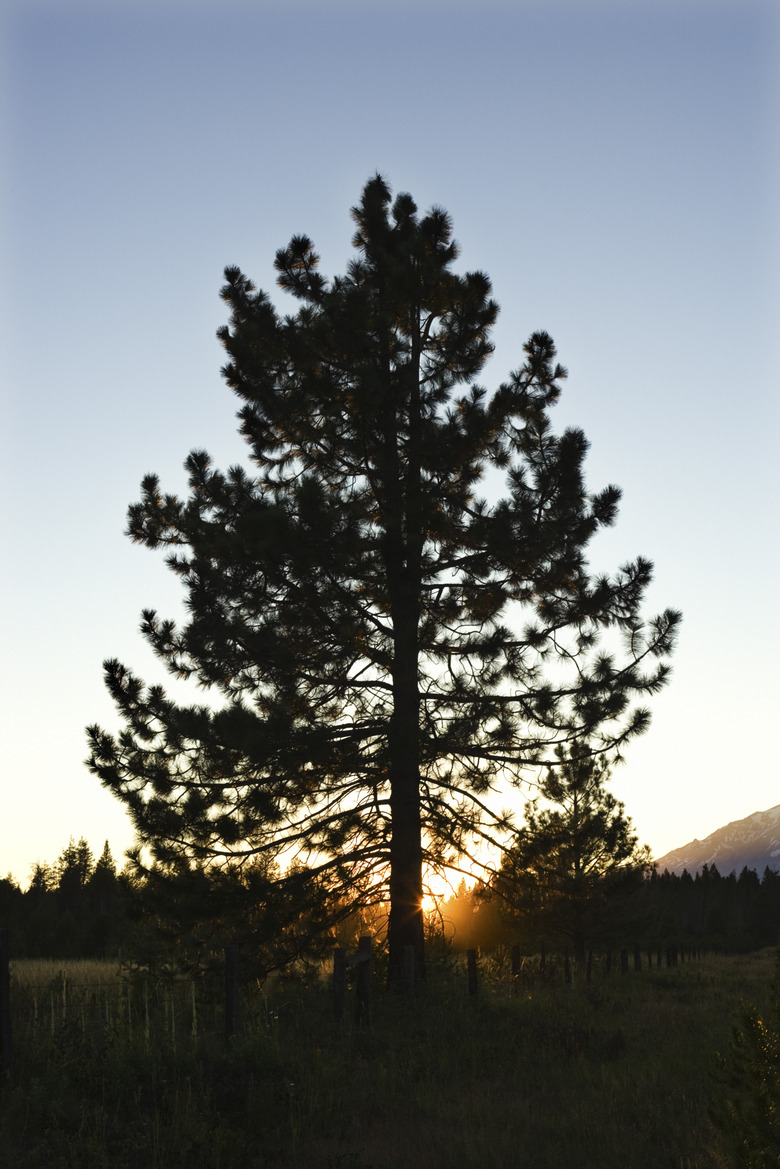Facts On Sap Flow In Pine Trees
Pine trees, which grow in forests throughout the world, are popular landscaping plants commonly used as foundation plants and to screen undesired views. The benefit of these coniferous trees is their uniform shape, rapid growth and little amount of required maintenance when cultivated properly. Pine trees produce sap in order to survive. This thick fluid carries nutrients and moisture throughout the tree.
Pine Tree Anatomy
Pine trees are made up of several layers. The heartwood, or xylem, is the innermost layer of the tree and is not involved in the flow of sap. The next layer, which is lighter in color and known as sapwood, is active in the tree's sap flow. Sapwood consists of small tubes that carry sap to all areas of the tree, including the needles. The next layer, which is thin and dark, is the cambium layer. Bark makes up the outermost layer of the pine tree.
- Pine trees, which grow in forests throughout the world, are popular landscaping plants commonly used as foundation plants and to screen undesired views.
- The next layer, which is lighter in color and known as sapwood, is active in the tree's sap flow.
Function of Sap
The sticky, yellowish sap of the pine tree acts like a bandage for the tree. The oozing of sap is a natural response to injuries such as broken bark, ripped-away needles, snapped branches and cut pine cones. The sap flows out of the wound and covers the area. In time the sap dries, forming a seal over the injury. This natural bandage is resistant to wood-eating insects, fungi and bacteria.
Seasonal Changes
Sap flow responds to seasons and temperatures as a form of survival adaptation. During the freezing weather of winter, pine trees go into a hibernation state. The lack of sunlight and warmth slows the flow of sap. In the spring and early summer, the strongest sap flow coincides with new growth.
- The sticky, yellowish sap of the pine tree acts like a bandage for the tree.
Moisture
The amount of water available at any time directly affects how much sap is available to flow through the pine tree. When water is plentiful, pine sap flows freely throughout the tree. As the sap reaches the needles and the topmost branches, the moisture in the fluid evaporates. Water-stressed pine trees produce less sap. Wrong planting locations and seasonal droughts will trigger this survival response in pine trees. If the water stress lasts long enough, the trees will die because of the lack of flowing sap.
Pests
Pine tree pests with sucking mouth parts can hinder the flow of sap. Pine needle scales, which are tiny insects, cause a grayish tint to the entire pine tree and stunt the needles by cutting off the supply of sap. This pest is mostly found on mugo and Scotch pine trees, but all varieties of pine are susceptible to such infestation. The massive number of scales can kill a mature pine tree. Pine aphids are small, soft-bodied sap feeders that stunt the growth of branches and needles by removing the sap from the pine tree. Infestations of aphids can kill young trees.
- The amount of water available at any time directly affects how much sap is available to flow through the pine tree.
- Pine aphids are small, soft-bodied sap feeders that stunt the growth of branches and needles by removing the sap from the pine tree.
References
- University of Georgia; Why Does a Pine Tree Produce Turpentine; Whit Gibbons; February 22, 2009
- Florida Center for Instructional Technology; Trees and Plants: Highways and Byways of Florida; 2005
- Wayne's Word An On-line Textbook of Natural History: The Anatomy of Wood
- University of Kentucky College of Agriculture; Common Sap Feeding Pine Pests; Joe T. Collins, et al.; 2010
- Wayne's Word An On-line Textbook of Natural History: Major Types of Chemical Compounds In Plants & Animals
